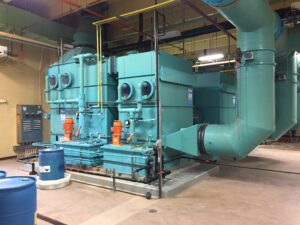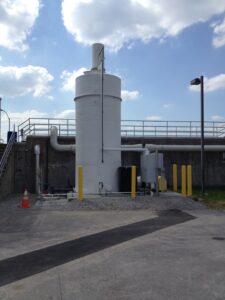Effective Ammonia Odor Removal Strategies for Industrial and Municipal Facilities
 Ammonia odors present significant challenges for industrial and municipal facilities. These odors can arise from various processes and, if not properly managed, can negatively impact air quality and regulatory compliance. Many facilities must address ammonia emissions to avoid potential fines and maintain community relations. Implementing effective odor control solutions is essential to achieving operational efficiency and environmental responsibility.
Ammonia odors present significant challenges for industrial and municipal facilities. These odors can arise from various processes and, if not properly managed, can negatively impact air quality and regulatory compliance. Many facilities must address ammonia emissions to avoid potential fines and maintain community relations. Implementing effective odor control solutions is essential to achieving operational efficiency and environmental responsibility.
Webster Environmental Associates (WEA) specializes in providing customized ammonia odor removal solutions. Our team works with facilities to identify odor sources and implement targeted strategies that align with regulatory standards and operational needs.
Understanding the Causes of Ammonia Odors
Ammonia odors originate from multiple sources in industrial and municipal settings. In wastewater treatment plants, the breakdown of organic materials and nitrogen-rich compounds releases ammonia. Industrial processes, such as food processing and chemical manufacturing, often produce ammonia as a byproduct. Agricultural operations, including livestock farming and fertilizer application, also contribute to ammonia emissions.
Ammonia is a naturally occurring compound with a distinct, pungent odor. It is highly volatile and can easily disperse into the air, making it difficult to contain. High concentrations of ammonia can pose health risks to workers and nearby residents, causing respiratory irritation and other health concerns. Additionally, ammonia emissions contribute to environmental issues such as air pollution and water contamination.
Advanced Technologies for Ammonia Odor Removal
Several technologies are available to effectively remove ammonia odors from air emissions. Each method is designed to address specific challenges and operational conditions.
- Chemical Scrubbing: This method uses chemical solutions to neutralize ammonia odors. The contaminated air passes through a scrubbing system, where chemicals react with ammonia to form harmless compounds. Chemical scrubbers are highly effective for facilities with high ammonia concentrations and stringent compliance requirements.
- Biofiltration: Biofilters use natural microorganisms to break down ammonia into non-odorous byproducts. The air passes through a media bed where bacteria and other microorganisms consume the ammonia. Biofiltration is a sustainable and cost-effective solution for long-term odor control.
- Carbon Adsorption: Activated carbon adsorbers trap ammonia molecules, effectively removing them from the air stream. This technology is ideal for facilities dealing with low-concentration emissions and seeking an efficient, low-maintenance solution.
The Importance of Customized Solutions
No two facilities face identical odor control challenges. Site-specific factors, such as facility layout, operational processes, and environmental conditions, influence the effectiveness of odor removal strategies. A one-size-fits-all approach often falls short of achieving desired results.
WEA works closely with clients to design customized solutions that address their unique odor control needs. Our team conducts thorough evaluations, including air sampling and odor dispersion modeling, to develop customized treatment plans. By understanding the specific challenges each facility faces, we can implement solutions that improve efficiency and minimize costs.
Our experience in successfully reducing ammonia odors is reflected in numerous projects across various industries. We have helped wastewater treatment plants, food processing facilities, and agricultural operations achieve compliance and improve air quality through targeted odor control measures.
Key Factors for Successful Implementation
 Effective ammonia odor removal requires a proactive approach. Several factors contribute to the long-term success of odor control systems.
Effective ammonia odor removal requires a proactive approach. Several factors contribute to the long-term success of odor control systems.
- Regular Monitoring: Routine air sampling and system checks help ensure that odor control measures continue to perform as expected.
- Proper Maintenance: Regular cleaning and replacement of system components, such as media in biofilters or chemical solutions in scrubbers, are critical for maintaining efficiency.
- System Selection: Choosing the right technology based on odor concentration, facility layout, and budget ensures long-term effectiveness.
- Regulatory Compliance: Facilities must meet local and federal air quality standards, which makes compliance a key consideration in odor control planning.
WEA provides ongoing support to help clients manage these factors effectively. Our team offers maintenance services and periodic system evaluations to keep odor control systems operating at peak performance.
Why Work with WEA?
WEA brings decades of experience in ammonia odor control. Our team delivers cost-effective and reliable solutions that align with each client’s operational goals. We take an independent, unbiased approach to ensure that the best technologies are selected without influence from manufacturers.
Our comprehensive services include:
- In-depth odor assessments to identify and prioritize odor sources.
- Custom-designed solutions tailored to each facility’s specific challenges.
- Implementation support, from planning and installation to ongoing monitoring.
- Expert guidance on meeting environmental compliance standards.
Partner with WEA for Ammonia Odor Solutions
Ammonia odor control is a critical aspect of maintaining regulatory compliance and protecting community relations. WEA provides effective, data-driven solutions that address the unique needs of each facility. Contact us today to discuss how our customized odor control strategies can help your facility achieve cleaner air and long-term success.
